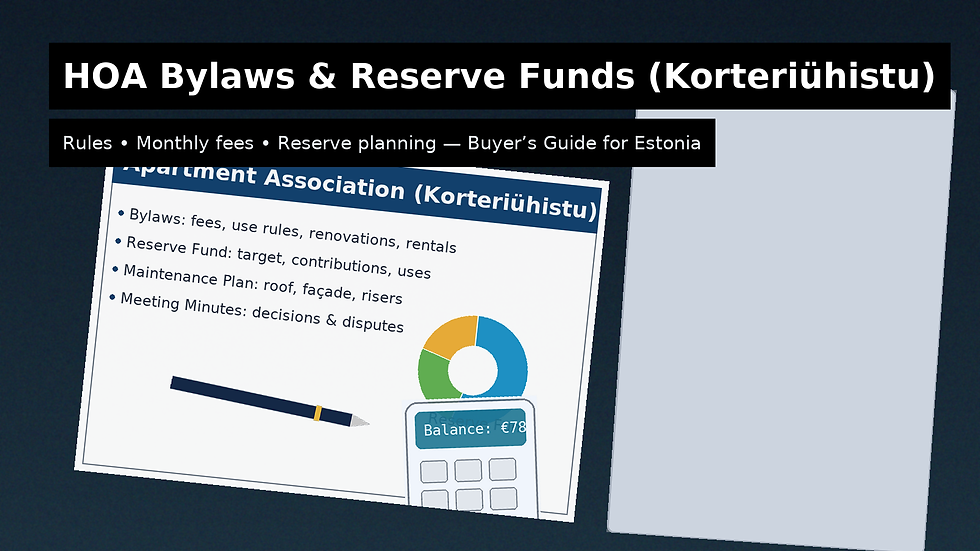Buying Properties in Estonia: HOA Bylaws & Reserve Funds (Korteriühistu) — The Smart Buyer’s Guide
- John Philips

- Sep 3
- 4 min read
Updated: Nov 13

Why HOAs Matter When You’re Buying Properties in Estonia
In Estonia, most apartments sit within a korteriühistu (apartment association/HOA). The HOA’s bylaws define how the building runs; its reserve fund pays for big-ticket items like roof, façade, and risers. A healthy HOA turns a nice flat into a low-stress investment. A weak one can turn it into a money pit. This guide gives you the quick checks, the numbers to read, and the clauses to add at notary so you buy with confidence.
Korteriühistu 101: What You’re Buying Into
Common obligations: You share costs for common areas, structure, and systems.
Decision-making: Owners vote per bylaws; some items need simple majority, others a qualified majority.
Documents to request:
Current bylaws (incl. voting, fee-setting, renovation rules)
Latest meeting minutes (decisions, disputes, arrears)
Budget & reserve-fund report (balance, planned works)
Maintenance plan (roof, façade, risers, elevators) Statement of owner arrears and any court actions
What Bylaws Usually Cover (and Why You Care)
Topic | What to Look For | Why It Matters |
Monthly fees | How fees are calculated (m², meters, mixed) | Predictability of costs |
Reserve fund | Required contribution, purpose, decision rules | Ability to fund capital projects |
Renovations | Owner approvals, quiet hours, façade rules | Avoid fines & neighbor disputes |
Short-term lets | Permitted or restricted | Rental strategy viability |
Pets & use | Reasonable restrictions vs vague bans | Lifestyle/tenant-fit |
Voting thresholds | Simple vs qualified majority items | Can needed works actually pass? |
Arrears policy | Timeline, interest, legal steps | Cash flow and fairness |
Reserve Fund Deep-Dive: What “Healthy” Looks Like
A reserve fund (RF) is the HOA’s savings account for capital works. You want:
A clear target (e.g., linked to a multi-year maintenance plan).
Regular contributions baked into monthly fees.
Ring-fenced use (roof, façade, risers, lifts—not day-to-day cleaning).
Illustrative RF reading (example only):
Signal | Healthy | Caution |
RF Balance vs 3-year plan | ≥ 60–100% funded | < 40% funded with big works due |
Annual RF contribution | Stable/increasing | Irregular or “holidayed” |
Planned works | Phased with quotes | Uncosted wishlist |
Owner arrears | Low and shrinking | High and rising |
Special assessments | Rare, well-justified | Frequent band-aids |
Tip: Compare the RF balance and incoming RF per year against the next 3–5 years of planned works. If the math doesn’t close, price it in or walk.
Buyer Due-Diligence Checklist (Copy/Paste)
☐ Bylaws received (voting, fee-setting, renovation & rental rules)
☐ Meeting minutes (last 12–24 months) reviewed for disputes and planned works
☐ Budget + reserve-fund report: current balance, annual contribution, forecasts
☐ Maintenance plan with timelines & quotes (roof, façade, risers, lift, heating)
☐ Arrears schedule (who, how much, collection progress)
☐ Utility contracts & metering (heat, water, electricity—apartment-level meters?)
☐ Insurance policy details (coverage, current claims)
☐ Upcoming special assessment? Amount per m² and due dates
☐ Short-term let policy if you plan furnished rentals
☐ House rules: quiet hours, storage, parking, pets
Reading the Numbers (Fast)
Monthly fee breakdown: admin + cleaning + utilities + reserve fund.
Per-m² comparison: benchmark against similar buildings/age in the area.
Forward works calendar: next 12, 24, and 36 months—how funded?
Arrears ratio: arrears / annual fees (lower is better).
Heat & energy: building EPC, heat metering (apartment-level reduces disputes).
Red Flags (Reprice or Walk Away)
No maintenance plan or one with no quotes.
RF near zero while façade/roof is already flagged.
Frequent special assessments and owner pushback.
Opaque or outdated bylaws; decisions stuck due to high voting thresholds.
Chronic arrears with weak collection policy.
Uninsured or underinsured building issues.
Negotiation Levers That Actually Work
Price adjustment equal to your share of imminent works.
Seller-funded escrow holdback released after HOA confirms works paid.
Close date set after a critical vote so you know the outcome.
Require delivery of quotes & contractor proposals as annexes.
Notary-Day Clauses (Copy/Paste)
“Completion is subject to Buyer’s receipt and review of bylaws, minutes, budget, reserve-fund statement, arrears schedule, insurance, and maintenance plan dated within 30 days.”
“Seller warrants no approved special assessment beyond ordinary fees unless disclosed in Annex X.”
“If the HOA approves a special assessment before completion, Seller to pay or escrow Buyer’s assessed share.”
“Seller delivers confirmation that monthly fees and any arrears on the unit are fully paid up to completion.”
Owner-Occupier vs Investor: What Changes?
Owner-occupier: prioritise house rules, quiet hours, storage, pets, and renovation permissions.
Investor: focus on short-term let policy, arrears discipline, metering (bill control), and predictable RF planning to protect yield.
FAQs
Is the reserve fund optional if the building looks new?
No. Even new buildings age; RF contributions build runway for future works and reassure lenders.
Can I refuse to pay for a special assessment?
No. If properly approved per bylaws, it’s binding on owners—price it in before you buy.
What if short-term lets are restricted?
Respect bylaws. Consider mid-term rentals or pivot to long-term tenants; or pick another building aligned with your strategy.
Bryan Estates: HOA Health Check (Add-On)
Rapid bylaw + minutes review with plain-English memo
Reserve-fund & works model vs your hold period
Negotiation playbook and notary-day clause pack
Lender-ready summary for smoother underwriting
Ready to evaluate an HOA before you commit?
Email info@bryanestates.ee or call +372 123 4567 for a same-day HOA dossier tailored to your target building—perfect for anyone buying properties in Estonia.



Comments